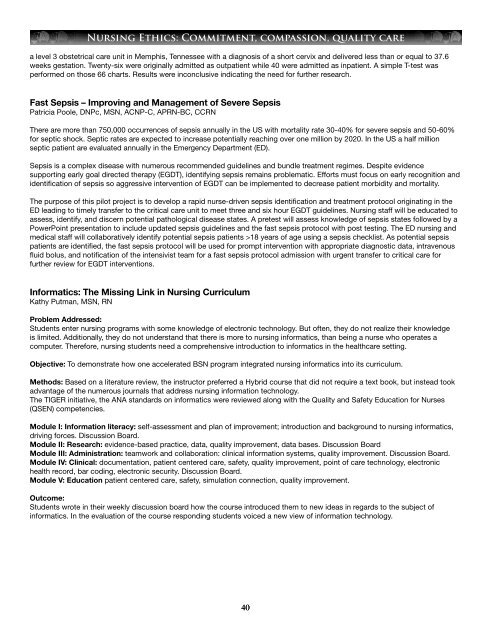Create successful ePaper yourself
Turn your PDF publications into a flip-book with our unique Google optimized e-Paper software.
Nursing Ethics: Commitment, compassion, quality care<br />
a level 3 obstetrical care unit in Memphis, Tennessee with a diagnosis of a short cervix and delivered less than or equal to 37.6<br />
weeks gestation. Twenty-six were originally admitted as outpatient while 40 were admitted as inpatient. A simple T-test was<br />
performed on those 66 charts. Results were inconclusive indicating the need for further research.<br />
Fast Sepsis – Improving and Management of Severe Sepsis<br />
Patricia Poole, DNPc, MSN, ACNP-C, APRN-BC, CCRN<br />
There are more than 750,000 occurrences of sepsis annually in the US with mortality rate 30-40% for severe sepsis and 50-60%<br />
for septic shock. Septic rates are expected to increase potentially reaching over one million by 2020. In the US a half million<br />
septic patient are evaluated annually in the Emergency Department (ED).<br />
Sepsis is a complex disease with numerous recommended guidelines and bundle treatment regimes. Despite evidence<br />
supporting early goal directed therapy (EGDT), identifying sepsis remains problematic. Efforts must focus on early recognition and<br />
identification of sepsis so aggressive intervention of EGDT can be implemented to decrease patient morbidity and mortality.<br />
The purpose of this pilot project is to develop a rapid nurse-driven sepsis identification and treatment protocol originating in the<br />
ED leading to timely transfer to the critical care unit to meet three and six hour EGDT guidelines. Nursing staff will be educated to<br />
assess, identify, and discern potential pathological disease states. A pretest will assess knowledge of sepsis states followed by a<br />
PowerPoint presentation to include updated sepsis guidelines and the fast sepsis protocol with post testing. The ED nursing and<br />
medical staff will collaboratively identify potential sepsis patients >18 years of age using a sepsis checklist. As potential sepsis<br />
patients are identified, the fast sepsis protocol will be used for prompt intervention with appropriate diagnostic data, intravenous<br />
fluid bolus, and notification of the intensivist team for a fast sepsis protocol admission with urgent transfer to critical care for<br />
further review for EGDT interventions.<br />
Informatics: The Missing Link in Nursing Curriculum<br />
Kathy Putman, MSN, RN<br />
Problem Addressed:<br />
Students enter nursing programs with some knowledge of electronic technology. But often, they do not realize their knowledge<br />
is limited. Additionally, they do not understand that there is more to nursing informatics, than being a nurse who operates a<br />
computer. Therefore, nursing students need a comprehensive introduction to informatics in the healthcare setting.<br />
Objective: To demonstrate how one accelerated BSN program integrated nursing informatics into its curriculum.<br />
Methods: Based on a literature review, the instructor preferred a Hybrid course that did not require a text book, but instead took<br />
advantage of the numerous journals that address nursing information technology.<br />
The TIGER initiative, the ANA standards on informatics were reviewed along with the Quality and Safety Education for Nurses<br />
(QSEN) competencies.<br />
Module I: Information literacy: self-assessment and plan of improvement; introduction and background to nursing informatics,<br />
driving forces. Discussion Board.<br />
Module II: Research: evidence-based practice, data, quality improvement, data bases. Discussion Board<br />
Module III: Administration: teamwork and collaboration: clinical information systems, quality improvement. Discussion Board.<br />
Module IV: Clinical: documentation, patient centered care, safety, quality improvement, point of care technology, electronic<br />
health record, bar coding, electronic security. Discussion Board.<br />
Module V: Education patient centered care, safety, simulation connection, quality improvement.<br />
Outcome:<br />
Students wrote in their weekly discussion board how the course introduced them to new ideas in regards to the subject of<br />
informatics. In the evaluation of the course responding students voiced a new view of information technology.<br />
40

















